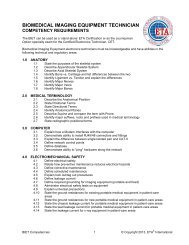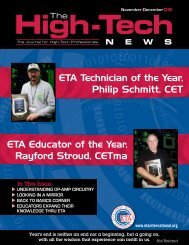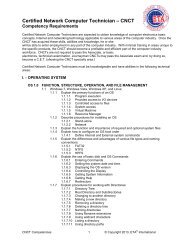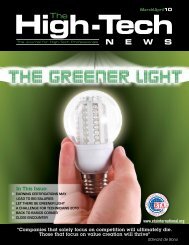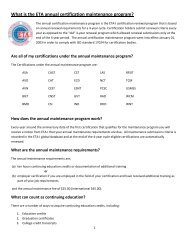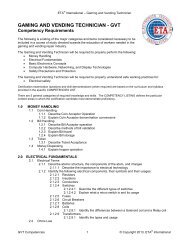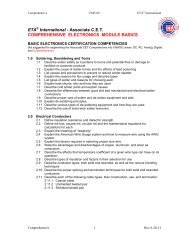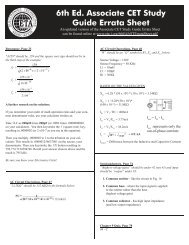TELECOMMUNICATIONS ELECTRONICS TECHNICIAN - TCM ...
TELECOMMUNICATIONS ELECTRONICS TECHNICIAN - TCM ...
TELECOMMUNICATIONS ELECTRONICS TECHNICIAN - TCM ...
Create successful ePaper yourself
Turn your PDF publications into a flip-book with our unique Google optimized e-Paper software.
<strong>TELECOMMUNICATIONS</strong><strong>ELECTRONICS</strong> <strong>TECHNICIAN</strong> - <strong>TCM</strong>CATEGORIES LIST(A listing of the major areas required for courses, training or study in Telecommunications Electronics)1.0 Cables and Cabling10.0 Internet2.0 Analog Telephony3.0 Equipment11.0 Network Infrastructuresand Topologies12.0 Office Wiring4.0 Telecom Safety13.0 Test Equipment5.0 Transmission ServiceProviders6.0 Distribution Methods14.0 Troubleshooting15.0 Transmission Protocols7.0 Computer16.0 Mathematics8.0 Digital Telephony17.0 Optical Wiring9.0 Interfacing18.0 Wireless Telephony<strong>TCM</strong> CompetencyElectronics Technicians Association, Int’l
Telecommunications Electronics Technician Items Listing<strong>TELECOMMUNICATIONS</strong><strong>ELECTRONICS</strong> <strong>TECHNICIAN</strong> - <strong>TCM</strong>ITEMS LIST(A listing of the major areas required for courses, training or study in Telecommunications Electronics)1.0 Cables and Cabling1.1 Unshielded twisted pair (UTP)1.2 RJ45/48 telephone connectors and fittings1.3 CAT 5 & 5e wiring1.4 10/100 base T1.5 T568A / T568B standards1.6 Cable TV wiring for data and voice1.7 Coax types RG 58, RG 59 and RG 61.8 Grounding of electronics equipment1.9 Single and multi-mode fiber optics1.10 Connector types and terminations2.0 Analog telephony2.1. History of the telephone industry2.2 Basic phone systems2.3 POTS, DID, OPX, tie lines and WATS lines2.4 Multiple phone lines2.5 PBX and explain basic switching methods2.6 Local loop2.7 Key system units (KSU)2.8 Central Office2.9 Tones, loop start, ground start and wink start2.10 CO, CPE.2.11 Dedicated lines, metered and switchedservices2.12 Broadband DSL and ISDN3.0 Equipment3.1 Telephone parts & components3.2 Telephone set disassemble and reassemble3.3 RS-232, RS-530, V.35 and USB interfaces4.0 Telecom Safety4.1 Safety procedures in the workplace4.2 Safety procedures in homes and businesses4.3 Safety procedures for outside equipment4.4 OSHA requirements4.5 Installer abilities required4.6 ESD procedures in the workplace5.0 Transmission Service Providers5.1 LEC’s—Local Exchange Carriers5.2 CLEC’s—Competitive Local ExchangeCarriers5.2 Regional Operating Companies5.3 RBOC’s—Regional Bell OperatingCompanies5.3 Independent telephone company5.4 Network control points5.5 In-band and Common Channel Signaling(CCS) and Signaling System 7 (SS7)5.6 T1 and T3 lines5.7 Multiplexing6.0 Distribution Methods6.1 Plug and adapter wiring6.2 Punch down blocks and tools—labeling6.3 T carrier (DS1’s)6.4 Repeaters6.5 Channel Banks6.6 Common Carrier6.7 Patch panels6.8 Ethernet and switch hubs6.9 Routers7.0 Computer7.1 Interrelationship—computers andcommunications technology7.2 Modems7.3 Worldwide numbering systems7.4 Network control points7.5 Databases7.6 CTI—Computer Telephony Integration7.7 Asynchronous Transfer Mode (ATM)8.0 Digital Telephony8.1 ISDN8.2 DSL8.3 Bundling and unbundling of telephoneservices8.4 Bytes, bits, packets and frames8.5 Caller ID8.6 Common Carrier9.0 Interfacing9.1 Telephone equipment—consumerelectronics interconnection problems9.2 Electrical power surge problems9.3 EIA, CTIA and ITU protocols and standards10.0 Internet10.1 Internet10.2 TCP/IP duties and protocols10.3 Security problems10.4 ISP’s11.0 Network Infrastructures andTopologies11.1 RS232 standard11.2 Transmission protocols11.3 LANs & WANs technology11.4 Installation and troubleshooting networks11.5 Sonet Ring<strong>TCM</strong> Competency 2 Electronics Technicians Association, Int’l.
Telecommunications Electronics Technician Items Listing<strong>TELECOMMUNICATIONS</strong><strong>ELECTRONICS</strong> <strong>TECHNICIAN</strong> - <strong>TCM</strong>ITEMS LIST(A listing of the major areas required for courses, training or study in Telecommunications Electronics)12.0 Office Wiring12.1 Building wiring standards12.2 Pre-wiring—wiring methods13.0 Test Equipment13.1 Certifying wired communications networks13.2 Bit Error Rate (TBerd, etc.)13.3 OTDR13.4 Micro-test13.5 Toners14.0 Troubleshooting14.1 Telephone test equipment14.2 Troubleshooting methods and loop testing15.0 Transmission Protocols15.1 Modulation schemes16.0 Telecom Mathematics16.1 Mathematics required for telecommunications17.0 Optical Wiring17.1 Fiber disposal—eye safety17.2 Optical cable types17.3 Conversion process—copper to fiber17.4 SONET17.5 DWDM, (Dense Wave Division Multiplexing)18.0 Wireless Telephony18.1 Wired vs. Cellular networks18.2 Cellular technology—architecture18.3 Spread Spectrum techniques18.4 TDMA and CDMA modulation18.5 Paging Services technology18.6 Telephone communications via satellites18.7 Components of satellite uplink and downlink18.8 Microwave transport<strong>TCM</strong> Competency 3 Electronics Technicians Association, Int’l.
Telecommunications Electronics Technician Competency Listing6.0 Distribution Methods6.1 Show ability to install and troubleshoot plug and adapter wiring6.2 The punch block and tools-show ability to properly perform connections and labeling6.3 Define T carrier (DS1’s)6.4 Show why and how repeaters are used in telephone communications6.5 Explain the usage of Channel Banks6.6 Define Common Carrier7.0 Computer7.1 Describe the interrelationship between computers and communications technology7.2 Explain how a Modem interfaces with the computer and show differences in common modems7.3 Describe worldwide numbering systems7.4 Define network control points7.5 Define database7.6 Explain CTI—Computer Telephony Integration7.7 Explain how Asynchronous Transfer Mode (ATM) is used and list benefits8.0 Digital Telephony8.1 Define ISDN8.2 Explain advantages and usage of DSL8.3 Explain ‘bundling’ and ‘unbundling’ of telephone services8.4 Describe the differences between bytes, packets and frames8.5 Explain the principles of Caller ID9.0 Interfacing9.1 Describe the problems which are commonly encountered when interconnecting consumer electronicsand telephone equipment.9.2 Explain electrical surge potentials and ways to combat damage from them9.3 Describe EIA, CTIA and ITU protocols and standards10.0 Internet10.1 Describe the Internet10.2 Explain TCP/IP duties and protocols10.3 Explain security problems with Internet service and list ways to improve security11.0 Network Infrastructures and Topologies11.1 Define RS232 and show how and where this standard is used11.2 Describe common transmission protocols11.3 Explain the difference between a LAN and a WAN11.4 Show an ability to install a small business WAN system and to troubleshoot problems in it12.0 Office Wiring12.1 List building wiring standards as set by ANSI, EIA/TIA and NFPA (NEC)12.2 Explain methods of pre-wiring and ways to wire existing buildings, including entry, attic and crawlspace precautions and methods of ‘fishing’ walls and routing wiring through false ceilings.13.0 Test Equipment13.1 Define the job of certifying wired communications networks13.2 Describe Bit Error Rate test equipment (TBerd, etc.); toners and OTDRs13.3 Demonstrate proficient use of an OTDR to troubleshoot cabling problems and to verify installed cable14.0 Troubleshooting14.1 Demonstrate proper usage of telephone test equipment as well as common DVM’s, signal tracers andsources, oscilloscopes and loop and network testing equipment14.2 Describe “Last Good, First Bad” troubleshooting methods and loop testing15.0 Transmission Protocols15.1 Define Modulation schemes<strong>TCM</strong> Competency 5 Electronics Technicians Association, Int’l.
Telecommunications Electronics Technician Competency Listing16.0 Telecom Mathematics16.1 Work math problems as required in telecommunications service and installation work17.0 Optical Wiring17.1 Safety-demonstrate the rules for disposal and eye safety when working with fiber optics equipment17.2 List different parameters and reasons for choosing each type of optical cable17.3 Describe the conversion process from copper to fiber signals17.4 Define and explain the term SONET17.5 Explain DWDM, Dense Wave Division Multiplexing18.0 Wireless Telephony18.1 Give an overview of the differences between wired telecommunications and cellular networks.18.2 Describe the concepts and architectures of cellular telephone systems18.3 Define Spread Spectrum broadcasting techniques18.4 Explain TDMA and CDMA modulation18.5 Give a description of how Paging Services operate18.6 Explain the principles of telephone communications via satellites18.7 Describe the major components of satellite uplink and downlink systemsSuggested Texts:Telecommunications and Data Communications Handbook; Ray Horak; Wiley; ISBN 978-0-470-04141-3Communications Systems and Networks, 3rd edition; Ray Horak; Wiley; ISBN 0-7645-4899-9Webster’s New World Telecom Dictionary; Ray Horak; Wiley; ISBN 978-0-471-77457-0Voice and Data Communications Handbook, Regis Bates/Donald Gregory, McGraw-Hill ISBN 0-07-006398-6Newton’s Telecom Dictionary, 14th edition, Harry Newton, Flatiron Publishing, ISBN 1-57820-023-7Telecommunications Distribution Methods Manual, multiple authors by BICSI, 8th ed. 800 242 7405Essential Guide to Telecommunications; Annabel Z. DoddCabling—The Complete Guide to Network Wiring; David Groth and Jim McVee; 2000; Sybex; ISBN 0-7821-2645-6; 820+ ppg; available at www.eta-i.org 800-288-3824 (ETA)Committee Members for <strong>TELECOMMUNICATIONS</strong> CET:Committee Chairman:Tom R. Janca, CETsrTechnician: Cricket Communications, Pueblo, COtrjanca@utilityethernetforum.orgjgarcaro@juno.comJTHoward@netscape.netstevedonalson@hotmail.comTomJ@cricketcommunications.comaprelwtz@swnebr.netgpselec@juno.comkwallace@charlesindustries.comothammer@hotmail.comajyoung99@hotmail.comeepar@aol.comjgonzalez@capefear.cc.nc.us<strong>TCM</strong> Competency 6 Electronics Technicians Association, Int’l.




